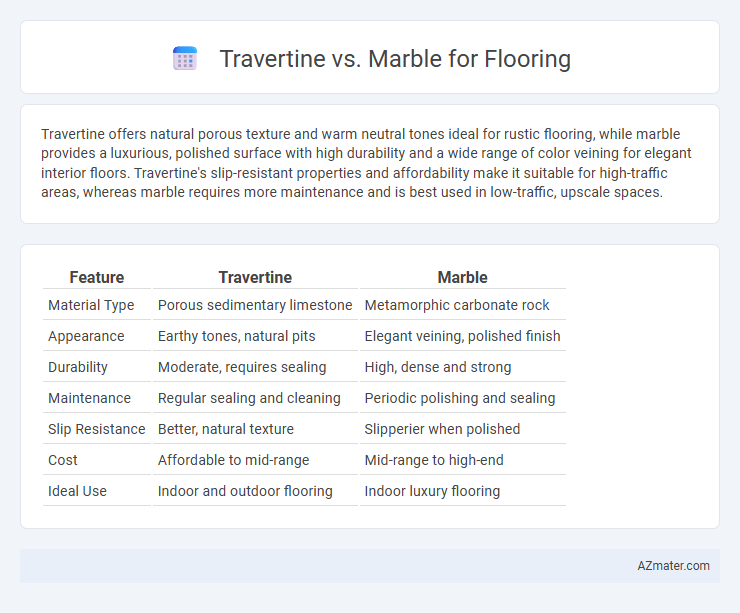Travertine offers natural porous texture and warm neutral tones ideal for rustic flooring, while marble provides a luxurious, polished surface with high durability and a wide range of color veining for elegant interior floors. Travertine's slip-resistant properties and affordability make it suitable for high-traffic areas, whereas marble requires more maintenance and is best used in low-traffic, upscale spaces.
Table of Comparison
| Feature | Travertine | Marble |
|---|---|---|
| Material Type | Porous sedimentary limestone | Metamorphic carbonate rock |
| Appearance | Earthy tones, natural pits | Elegant veining, polished finish |
| Durability | Moderate, requires sealing | High, dense and strong |
| Maintenance | Regular sealing and cleaning | Periodic polishing and sealing |
| Slip Resistance | Better, natural texture | Slipperier when polished |
| Cost | Affordable to mid-range | Mid-range to high-end |
| Ideal Use | Indoor and outdoor flooring | Indoor luxury flooring |
Introduction to Travertine and Marble Flooring
Travertine and marble are both popular natural stone choices for flooring, prized for their durability and elegant appearance. Travertine, formed from calcium carbonate deposits in mineral springs, features a porous surface with natural pits and veins, offering a unique, rustic look while being slip-resistant and heat-tolerant. Marble, a metamorphic rock predominantly composed of calcite, is known for its smooth, polished surface and distinctive veining patterns, providing a luxurious and timeless aesthetic suitable for high-traffic areas when properly sealed.
Key Differences Between Travertine and Marble
Travertine flooring features a porous, textured surface with natural pits and voids, offering a rustic appearance, while marble boasts a smooth, polished finish with prominent veining and a more luxurious look. Travertine is generally softer and more porous, requiring sealing to prevent stains, whereas marble is denser and more durable but can be prone to scratching and etching from acidic substances. Both stones vary in color and pattern, but marble typically presents richer color variations, making it a preferred choice for elegant, high-end flooring designs.
Appearance and Aesthetic Appeal
Travertine flooring offers a natural, earthy appearance with its porous texture and warm, neutral tones, creating a rustic and timeless aesthetic ideal for Mediterranean or traditional designs. Marble provides a sleek, polished surface with distinctive veining patterns in a wide range of colors, lending a luxurious and elegant atmosphere suited to modern and classic interiors. Both stones enhance visual appeal through unique natural variations, but marble's high gloss finish typically delivers a more refined and sophisticated look compared to travertine's matte and textured charm.
Durability and Longevity
Travertine offers excellent durability with natural resistance to cracks and chips, making it ideal for high-traffic flooring areas. Marble, while visually luxurious, is softer and more prone to scratching and etching, requiring regular maintenance to preserve its longevity. Both stones can last decades, but travertine tends to maintain its structural integrity better under heavy use.
Maintenance Requirements
Travertine flooring requires regular sealing every 1 to 2 years to prevent staining and moisture damage due to its porous surface, while marble demands more frequent sealing because of its higher susceptibility to scratches and etching from acidic substances. Both natural stones benefit from pH-neutral cleaners and prompt spill cleanup to maintain their polished appearance, but marble's sensitivity often necessitates professional refinishing over time. Proper maintenance significantly extends the lifespan and aesthetic appeal of travertine and marble floors, ensuring durability in high-traffic areas.
Cost Comparison
Travertine flooring typically costs between $3 to $7 per square foot, offering a more budget-friendly option compared to marble, which ranges from $10 to $20 per square foot. Installation prices for both stones vary, with travertine averaging $8 to $15 per square foot, while marble installation can reach $15 to $25 per square foot due to its density and polishing requirements. Maintenance and durability also influence long-term expenses, as travertine requires more frequent sealing compared to the generally harder and more resilient marble surface.
Installation Process
Travertine flooring requires a more meticulous installation process due to its porous surface, which necessitates sealing before and after laying to prevent staining and moisture absorption. Marble, although denser, demands precise cutting and leveling to avoid cracking and chipping, with grout lines needing careful sealing to maintain durability. Both materials benefit from experienced professional installation to ensure longevity and a seamless finish, but travertine's texture often calls for extra attention during adhesive application to secure tiles firmly.
Pros and Cons of Travertine Flooring
Travertine flooring offers natural durability and a unique, elegant texture, making it a popular choice for both indoor and outdoor spaces. Its porous surface requires regular sealing to prevent staining and water damage, which can increase maintenance efforts compared to marble. While travertine provides a non-slip surface ideal for wet areas, it is softer and more prone to scratching than marble, affecting its longevity in high-traffic zones.
Pros and Cons of Marble Flooring
Marble flooring offers a luxurious and elegant appearance with its natural veining and glossy finish, making it a popular choice for high-end interiors. It is highly durable and can increase property value, but it requires regular sealing to prevent stains and is prone to scratching and etching from acidic substances. While marble provides a cool surface ideal for warmer climates, its higher cost and maintenance needs may not suit every budget or lifestyle.
Choosing the Best Option for Your Home
Travertine flooring offers natural durability and a porous texture that enhances slip resistance, making it ideal for high-traffic areas in homes. Marble provides a luxurious, polished finish with unique veining patterns but requires more maintenance due to its susceptibility to scratches and stains. Selecting the best option depends on prioritizing durability and low maintenance with travertine or opting for elegance and classic aesthetics with marble flooring.

Infographic: Travertine vs Marble for Flooring
 azmater.com
azmater.com